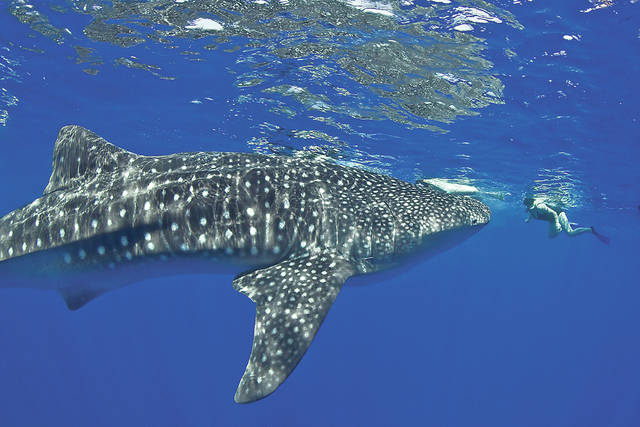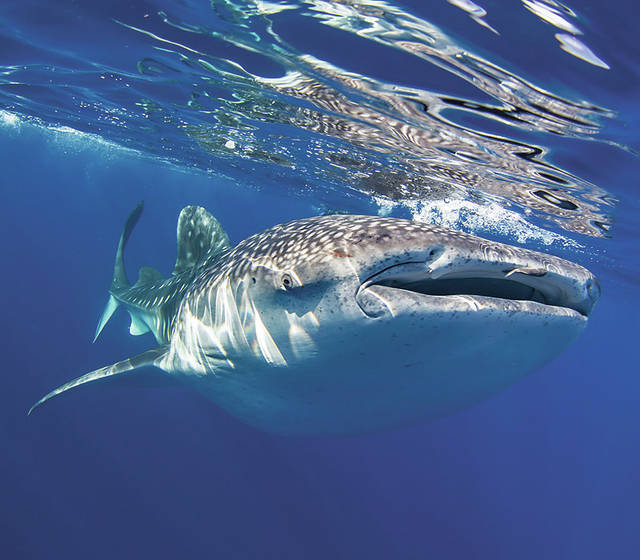KAILUA-KONA — Maria Harvey worked for seven years in various capacities off the shores of West Hawaii before she saw her first whale shark.
Since then, she’s seen something near 30 members of the endangered species in Hawaii waters.
A marine researcher and disentanglement specialist, the seemingly excess number of whale sharks piqued Harvey’s curiosity, as the world’s largest extant fish species weren’t regarded as all that typical in Hawaii.
In late 2016, Harvey came up with the concept for Hawaii Uncharted Research Collective (HURC), a nonprofit organization that became a legal entity last summer and began charting whale sharks around the islands last fall.
“Whale sharks are considered an endangered species,” Harvey, chief research coordinator, said of her motivation to develop HURC. “So if they are in our waters, we need to understand how to protect them and how to preserve them.”
In years past, whale sharks, which can grow to more than 30 feet in length and weigh more than 20 tons, have been overfished and eaten regularly in several places around the world. Fishing practices geared at different aquatic targets, however, contributed similarly to the species’ more than 50 percent worldwide decline since 1975, explained Stacia Goecke, chief research scientist and co-founder of HURC.
Fishermen employing purse seine methods, using nets to encircle schools of fish such as tuna, create an element of bycatch. Bycatch is comprised of the marine species trapped in purse seine nets unintentionally.
Lawmakers and environmentalists have made significant strides curbing both practices of intentionally and unintentionally ensnaring whale sharks globally, Goecke said.
But the population remains in peril, particularly in U.S. waters where the only restriction applying to whale sharks is that no one is allowed to catch and sell them for use in aquariums.
“Besides that, there’s absolutely no protection for them in U.S. waters,” Goecke said. “And that’s probably because they’re not known to be in U.S. waters with any regularity.”
But HURC aims to be the first organization to change that, Harvey said.
To her knowledge, the collective is the only group in the country conducting whale shark research.
Harvey said Wildbook, an international database with which HURC crossmatches whale sharks it documents in an attempt to generate migratory data, also told her they were unaware of any U.S.-based organization conducting similar work.
Utilizing current and historical data, HURC has identified 120 unique individual whale sharks in Hawaii waters. The first documented siting stretches back to 1991 with a spike coming in 2014. Some of that had to do with the advent of affordable underwater digital cameras, Goecke said, but in the years since numbers have continued to rise.
Goecke said ocean goers have reported more sightings in 2017 and 2018 than during any other years, to date more than 50, and there’s still half of 2018 to go.
“It’s pretty amazing,” she added. “We never thought we’d get this many sightings, that they’d be this common this soon.”
Harvey said the reason whale shark research is lacking in U.S. waters is because the animals don’t tend to congregate here as they do in places like Mexico and Peru. Without long-term funding or an established local infrastructure, traveling to Hawaii on a whim to study whale sharks is a financially risky proposition for scientists.
HURC might seem an unlikely outfit to try and undertake the task. The collective is small, only four original, co-founding members, all of whom currently work on a volunteer basis, Harvey said.
They’ve teamed up with five volunteer ambassadors on different islands to spread the word of their work, and in the midst of applying for grants and soliciting private funding, Harvey and her team hope to be able to absorb academic interns down the road.
For now, though, the most important element of the research and its long-term prospects is what Harvey described as a “citizen science effort.” The collective is counting on its built-in infrastructure of island ties to serve this end in the organization’s early years.
For months the team gave presentations across Hawaii Island at places like Ola Brew, the Kona Science Cafe and Jack’s Diving Locker to solicit help and explain what they’re looking for. Ambassadors spread similar information on other islands.
For official documentation, a photo or a video of a whale shark must be obtained so it can be confirmed. Footage of the animal’s left side is crucial, as each carries a unique pattern there allowing it to be identified, logged and crossmatched. Ideally, a date of the sighting would be included.
Mariners can report active sightings by calling the HURC hotline at (808) 465-4872. HURC members will frequently be on the water looking to initiate sightings of their own and will respond to incoming calls.
Harvey and Goecke both noted whale sharks should be approached with caution, in the interests of human safety and not disturbing the animals. A code of conduct and other organizational information can be found on the HURC website at www.hawaiiuncharted.org.
Harvey said HURC probably needs to generate six figures annually to conduct the kind of research necessary to accomplish its goals.
To date, HURC has only obtained one grant, from the California-based PADI Foundation, to construct a laser photogrammetry rig. The rig employs two lasers with a camera to figure out the exact length of a whale shark with a couple of feet, which will allow HURC to delineate between juvenile and adult members of the species.
Harvey said they also hope to fund satellite tracking and tag each whale shark’s dorsal fin, which would provide information on where migrations begin and end, travel depth and temperature.
HURC also hopes to employ monofilament tags, which will send a location point every time the animal breaks the ocean surface, allowing for a more complete understanding of migratory patterns.








